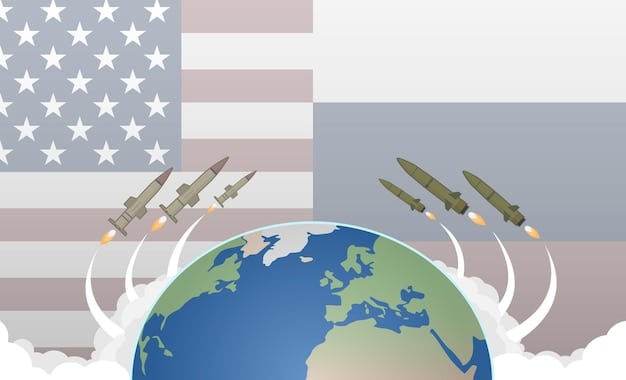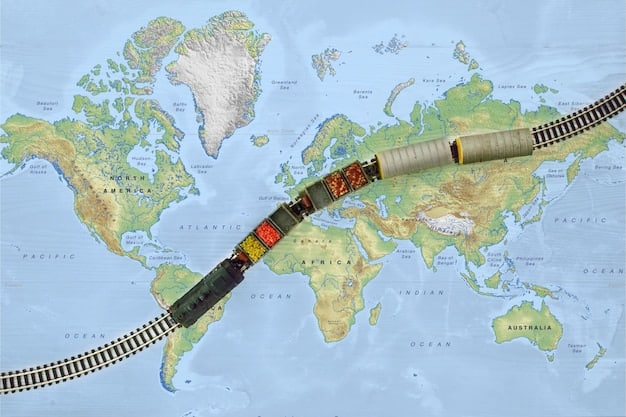US Nuclear Modernization: Impact on Global Disarmament

The US nuclear modernization program presents complex implications for global nuclear disarmament efforts, potentially undermining arms control agreements and escalating international tensions while also aiming to maintain a credible deterrent.
The United States’ commitment to modernizing its nuclear arsenal has sparked a global debate, questioning whether this strategy strengthens national security or undermines international efforts toward nuclear disarmament. Understanding the implications of this program is crucial for assessing the future of global stability and arms control.
Understanding the US Nuclear Modernization Program
The US Nuclear Modernization Program is a comprehensive effort to upgrade and maintain the nation’s nuclear arsenal. This initiative involves replacing aging weapons systems, improving infrastructure, and enhancing research and development capabilities. The program aims to ensure that the US maintains a credible nuclear deterrent in the face of evolving global threats.
Rationale Behind Modernization
The primary justification for the modernization program is to address the aging infrastructure of the US nuclear arsenal. Many existing systems are decades old and require significant upgrades to remain reliable and effective. Proponents argue that a modernized arsenal is essential for deterring potential adversaries and maintaining strategic stability.
Key Components of the Program
The modernization program includes several key components, such as the development of new intercontinental ballistic missiles (ICBMs), submarine-launched ballistic missiles (SLBMs), and strategic bombers. Additionally, it involves upgrading nuclear command, control, and communications systems to ensure secure and reliable operations.
- Developing new ICBMs to replace the aging Minuteman III missiles.
- Upgrading SLBMs to enhance the capabilities of nuclear-powered ballistic missile submarines (SSBNs).
- Modernizing strategic bombers, including the B-2 Spirit and the B-21 Raider.
- Enhancing nuclear command, control, and communications systems for improved security.
The modernization program seeks to ensure that the US maintains a diverse and robust nuclear triad, consisting of land-based missiles, submarine-launched missiles, and strategic bombers. This diversification is intended to enhance deterrence by making it more difficult for any potential adversary to neutralize the US nuclear arsenal in a single strike.

Impact on Nuclear Non-Proliferation Efforts
The US Nuclear Modernization Program has significant implications for global nuclear non-proliferation efforts. While the US argues that modernization is necessary for maintaining deterrence and stability, critics contend that it could undermine international efforts to reduce the spread of nuclear weapons.
The NPT and Disarmament Obligations
The Treaty on the Non-Proliferation of Nuclear Weapons (NPT) is a landmark international treaty aimed at preventing the spread of nuclear weapons and promoting disarmament. Under the NPT, nuclear weapon states are obligated to pursue negotiations in good faith on effective measures relating to nuclear disarmament. The US Nuclear Modernization Program has raised concerns about whether the US is fulfilling its disarmament obligations under the NPT.
Potential for a New Arms Race
One of the primary concerns is that the modernization program could trigger a new arms race among nuclear weapon states. If the US modernizes its arsenal, other countries may feel compelled to do the same, leading to a dangerous escalation of nuclear capabilities. This could undermine global stability and increase the risk of nuclear conflict.
Impact on International Norms
The US modernization program could weaken international norms against nuclear proliferation. By investing heavily in its nuclear arsenal, the US may send a message that nuclear weapons are still relevant and necessary, potentially encouraging other countries to pursue their own nuclear ambitions.
- Undermining the NPT’s disarmament goals.
- Encouraging other nations to modernize their nuclear arsenals.
- Weakening international norms against nuclear weapon proliferation.
The modernization program sends mixed signals to the international community. While the US claims to be committed to disarmament, its actions suggest a continued reliance on nuclear weapons. This inconsistency can erode trust and undermine efforts to achieve a world without nuclear weapons.
Geopolitical Implications and Global Security
The US Nuclear Modernization Program has far-reaching geopolitical implications that could affect global security. The program’s impact on strategic stability, regional dynamics, and international relations warrants careful consideration.
Deterrence and Strategic Stability
Proponents of the modernization program argue that it enhances deterrence by ensuring that the US maintains a credible nuclear threat. They believe that a modernized arsenal can discourage potential adversaries from initiating aggression against the US or its allies. However, critics argue that modernization could also increase instability by lowering the threshold for nuclear use.
Regional Dynamics
The modernization program could affect regional dynamics, particularly in areas where nuclear-armed states confront each other. For example, the program could exacerbate tensions between the US and Russia, as well as between India and Pakistan. The deployment of new or upgraded nuclear weapons in these regions could heighten the risk of miscalculation and conflict.
International Relations
The modernization program could strain relations between the US and other countries, especially those that advocate for nuclear disarmament. Countries that view nuclear weapons as immoral or unnecessary may criticize the US for investing in its nuclear arsenal. This could lead to diplomatic friction and undermine international cooperation on other issues.
- Maintaining a credible nuclear deterrent against potential adversaries.
- Exacerbating tensions in regions with nuclear-armed states.
- Creating diplomatic friction with countries advocating for disarmament.
The US Nuclear Modernization Program is a complex issue with no easy answers. While it may enhance deterrence in some respects, it also carries significant risks for global security. Careful consideration of these risks and benefits is essential for ensuring that the program does not undermine international efforts toward nuclear disarmament.

Arms Control Agreements and Verification Challenges
The US Nuclear Modernization Program presents challenges for arms control agreements and verification mechanisms. Existing treaties may not adequately address the types of weapons and technologies being developed under the program, raising questions about compliance and enforcement.
Challenges to Existing Treaties
The New Strategic Arms Reduction Treaty (New START) is the only remaining treaty limiting US and Russian nuclear forces. However, the modernization program could introduce new types of weapons that are not covered by New START, potentially undermining the treaty’s effectiveness. Furthermore, the treaty is set to expire in 2026, and its renewal is uncertain.
Verification Issues
Verifying compliance with arms control agreements is a complex task, especially in an era of rapidly evolving technology. The modernization program includes developments that may be difficult to monitor and verify, such as new types of warheads and delivery systems. This could erode confidence in arms control agreements and make it harder to achieve further reductions in nuclear weapons.
Need for New Approaches
The challenges posed by the modernization program may require new approaches to arms control and verification. This could include developing new treaties that address emerging technologies, as well as strengthening existing verification mechanisms. It may also require greater transparency and information sharing among nuclear weapon states to build trust and confidence.
The Role of International Organizations
International organizations such as the International Atomic Energy Agency (IAEA) play a crucial role in verifying compliance with arms control agreements. However, the IAEA’s capabilities may need to be enhanced to address the challenges posed by the modernization program. This could include providing the IAEA with additional resources and expertise to monitor new types of nuclear weapons and technologies.
The US Nuclear Modernization Program presents significant challenges for arms control agreements and verification mechanisms. Addressing these challenges will require a concerted effort by nuclear weapon states and international organizations to develop new approaches and strengthen existing tools.
Economic Costs and Resource Allocation
The US Nuclear Modernization Program is a costly undertaking, with significant implications for resource allocation and budget priorities. The program’s economic costs could divert resources from other important areas, such as healthcare, education, and infrastructure.
Budgetary Implications
The Congressional Budget Office (CBO) estimates that the modernization program will cost hundreds of billions of dollars over the next several decades. These costs include the development, production, and deployment of new nuclear weapons systems, as well as the maintenance of existing systems. The budgetary implications of the program are substantial and could affect other areas of government spending.
Opportunity Costs
The resources spent on the modernization program could be used for other purposes, such as addressing pressing social and economic needs. These opportunity costs should be carefully considered when evaluating the program’s merits. Some argue that investing in healthcare, education, and infrastructure would provide greater benefits to society than investing in nuclear weapons.
Economic Impact
The modernization program could have both positive and negative economic impacts. On the one hand, it could create jobs in the defense industry and stimulate technological innovation. On the other hand, it could divert resources from more productive sectors of the economy and contribute to income inequality.
Transparency and Accountability
Given the significant costs associated with the modernization program, it is essential to ensure transparency and accountability in its implementation. This includes providing the public with detailed information about the program’s costs and benefits, as well as establishing mechanisms to prevent waste and fraud.
The US Nuclear Modernization Program carries substantial economic costs that could affect resource allocation and budget priorities. Careful consideration of these costs is essential for ensuring that the program is implemented in a responsible and sustainable manner.
Ethical and Moral Considerations
The US Nuclear Modernization Program raises profound ethical and moral considerations about the role of nuclear weapons in the 21st century. These considerations include the morality of nuclear deterrence, the risk of accidental use, and the potential for catastrophic humanitarian consequences.
Morality of Nuclear Deterrence
Nuclear deterrence is based on the idea that the threat of nuclear retaliation can prevent aggression by potential adversaries. However, some argue that this strategy is morally problematic because it relies on the willingness to inflict unimaginable suffering on civilian populations. They contend that nuclear deterrence is a form of terrorism and is therefore morally unjustifiable.
Risk of Accidental Use
The risk of accidental nuclear use is a persistent concern, despite efforts to improve safety and security. Human error, technical malfunctions, and miscalculations could all lead to the accidental launch of nuclear weapons. The consequences of such an event would be catastrophic, potentially triggering a global nuclear war.
Humanitarian Consequences
The humanitarian consequences of nuclear war would be devastating. A nuclear conflict could kill hundreds of millions of people, destroy infrastructure, and contaminate the environment. The long-term effects of nuclear war could include widespread disease, famine, and social disruption. Some argue that the potential for such catastrophic consequences outweighs any possible benefits of nuclear weapons.
| Key Aspects | Brief Description |
|---|---|
| 🛡️ Deterrence | Aims to maintain a credible nuclear deterrent to prevent attacks. |
| 🌍 Non-Proliferation | Concerns about sparking a new arms race and undermining disarmament efforts. |
| 💰 Economic Costs | Significant financial resources are required, impacting budget priorities. |
| 🤝 Arms Control | Challenges existing treaties and requires enhanced verification methods. |
Frequently Asked Questions
▼
The US Nuclear Modernization Program is a comprehensive effort to upgrade and maintain the United States’ nuclear arsenal, involving replacing aging systems and improving infrastructure.
▼
Critics argue that it could undermine global disarmament efforts by signaling a continued reliance on nuclear weapons and potentially triggering a new arms race.
▼
The program is estimated to cost hundreds of billions of dollars over several decades, potentially diverting resources from other critical areas.
▼
The New Strategic Arms Reduction Treaty (New START) is the only remaining treaty limiting US and Russian nuclear forces, but its future is uncertain after 2026.
▼
Ethical concerns include the morality of nuclear deterrence, the risk of accidental use, and the potential for catastrophic humanitarian consequences during nuclear conflict.
Conclusion
In conclusion, the US Nuclear Modernization Program presents a complex equation of strategic necessity and global risk. While proponents argue that it is essential for maintaining a credible deterrent and ensuring national security, critics raise concerns about its impact on nuclear disarmament efforts, arms control agreements, and global stability. Addressing these concerns requires a balanced approach that considers both the strategic realities of the 21st century and the urgent need to reduce the risk of nuclear war.





